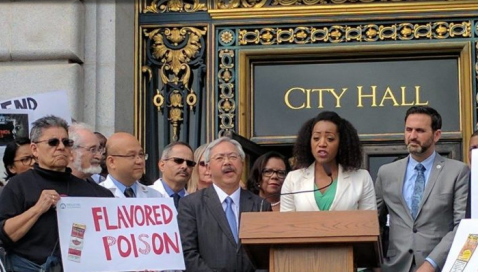- Download Case Study HERE:
Download case study
- Introduction:
In 2017, the San Francisco Board of Supervisors unanimously passed a policy that prohibits the
sale and distribution of flavored tobacco products, including mentholated cigarettes. San
Francisco’s Flavored Tobacco Sale policy (hereafter, referred to as the Flavored Tobacco Sale
policy) aims to eliminate youth access to flavored tobacco products and reduce the
disproportionate impact of flavored tobacco on communities of color. At the time of the
policy’s adoption, San Francisco was the only municipality to have adopted a comprehensive
policy that limits flavored tobacco sales at a citywide level.The San Francisco Tobacco Free Project (TFP)—a project of the San Francisco Department of
Public Health—and its partner community coalition—the Tobacco-Free Coalition—were
actively engaged in the development of and support for the policy campaign in San Francisco.
This case study describes this policy in San Francisco, examines the key strategies and lessons
learned from the campaign that led to the policy adoption, and discusses the intended impact of
the policy.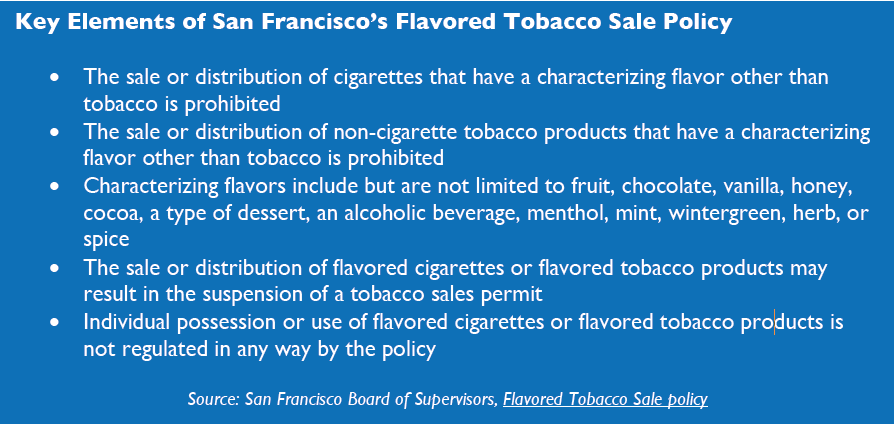
- Flavored Tobacco as a Social Justice Issue:
What is flavored tobacco?
The Flavored Tobacco Sale policy defines flavored tobacco as any tobacco product (cigarettes, hookah tobacco, cigars, blunts, vaping liquid, etc.) with a characterizing flavor (fruit, chocolate, mint/menthol, candy, etc.).Who uses flavored tobacco?
Flavored-tobacco products have the same negative health effects as unflavored tobacco. Flavored tobacco is marketed and sold in a way that is attractive and highly accessible to youth (Figure 1). Through a combination of visually appealing packaging, cheap prices (e.g., little cigars for 50 cents), and plentiful flavor options, flavored tobacco products appear—and can even taste—very similar to candy (see below). Furthermore, the characterizing flavors in flavored tobacco products mask the harsh flavor of tobacco, making it much easier for youth to start using tobacco and become addicted. Tobacco companies are particularly keen on establishing smoking habits in adolescents, which could cause them to become regular smokers as they get older. Of the 5.6 million Americans under 18 who smoke today (1) 80 percent started smoking using a flavored tobacco product.(2)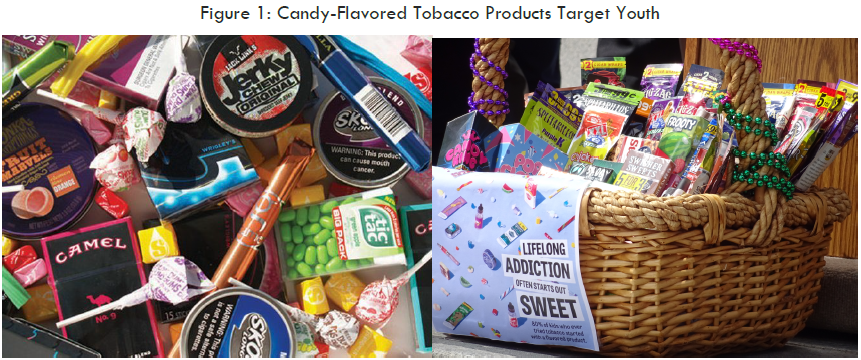
Similarly, there is clear evidence of flavored tobacco’s disproportionate impact on minority populations. African Americans, specifically, have been targeted by mentholated cigarette brands Kool, Newport, and Salem through the use of culturally tailored advertising images and messages for decades (3). This has resulted in elevated mentholated-cigarette smoking rates in the African American community. An estimated 70 percent of African American adult smokers smoke mentholated cigarettes, compared to fewer than 30 percent in other ethnic groups (4). Studies have shown that people who smoke mentholated cigarettes are much less successful at quitting smoking than non mentholated-cigarette smokers, regardless of race (5). As a result, African Americans bear inequitable and long-term negative health impacts due to targeted advertising from menthol-flavored tobacco producers (4).
How is flavored tobacco regulated?
The federal government currently regulates flavored cigarettes but not non-cigarette flavored tobacco products (i.e., blunts, wraps, cigarillos, snuff, etc.). In 2009, Congress banned the production and sale of flavored cigarettes (6). However, this legislation did not ban mentholated cigarettes, despite strong efforts by the Congressional Black Caucus to include mentholated cigarettes on the list of restricted products (7). Furthermore, this regulation did not establish any limitations on the sale or production of flavored non-cigarette tobacco products. As a result, tobacco producers have continued to sell mentholated cigarettes, and an increasing variety of flavored e-cigarettes, blunts, and cigarillos have been marketed to entice first-time smokers.Several municipal jurisdictions have passed additional policies to regulate flavored tobacco at the local level. The implementation of these ordinances varies by region, ranging from solely allowing adults-only tobacco stores to sell flavored tobacco products (8) to banning the sale of flavored tobacco products near specific sites, such as schools (9,10). Some of these policies explicitly ban mentholated tobacco products (including cigarettes), while others do not, allowing mentholated tobacco products to continue being sold legally under current FDA regulations. Within California, several counties and cities have recently passed legislation regulating the sale or distribution of flavored cigarettes and flavored tobacco products, including Berkeley, whose legislation predated the San Francisco policy. San Francisco’s Flavored Tobacco Sale policy passed in July 2017, with Contra Costa County, Oakland, and San Leandro passing their own flavored tobacco regulation soon after.
Please see Appendix A for a timeline of flavored-tobacco regulation in the Bay Area.
- Successful Strategies for Passing Flavored-Tobacco Regulation:
At the time of its passage, San Francisco’s Flavored Tobacco Sale policy was the most comprehensive flavored tobacco regulation of any municipality in the United States. A key prerequisite for the success of this policy campaign was a dedicated network of community organizations that had trusting relationships with local policymakers. This section describes how the San Francisco Tobacco-Free Coalition secured unanimous support for the policy from the Board of Supervisors and highlights lessons learned that other communities might apply in their efforts to regulate flavored tobacco products (Figure 2).
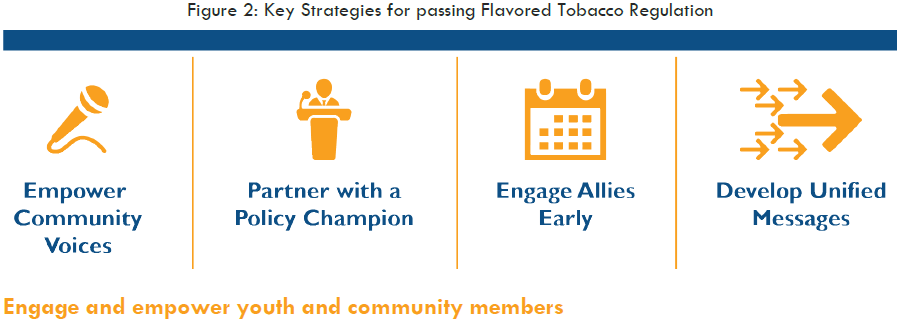
Engage and empower youth and community members
The San Francisco Tobacco Free Coalition mobilized and coordinated a high volume of community stakeholders to participate in the policy process. These organizations include the African American Tobacco Control Leadership Council, Breathe California Golden Gate Public Health Partnership (hereafter referred to as “Breathe California”), the Youth Leadership Institute, the American Cancer Society Cancer Action Network, and researchers from UCSF, among others.
One specific tool for empowering community based organizations to activate youth and other community members is the Community Action Model (CAM). The CAM is a five-step, community-driven process designed to support emerging community leaders in identifying policy solutions to eliminate health disparities. The San Francisco Department of Public Health’s Tobacco-Free Project oversees the funding and training of community-based organizations that participate in CAM.Breathe California, a lung health organization, received a CAM grant in 2015. Their CAM project, known as Project E-NUFF, engaged a dozen young-adult community members to conduct research, analyze data, develop strategic communications materials, and educate policymakers and key stakeholders on the topic of flavored and mentholated tobacco products. The E-NUFF team conducted research in fall 2015 and analyzed the results through summer 2016. Between that time and the adoption of the San Francisco Flavored Tobacco Sale policy, they did the following:
• Published a letter to the editor calling for an end to the sale of flavored tobacco
products in two newspapers before the policy was being considered by the Board of
Supervisors
• Developed an educational packet to present to public officials, their community, and the
Board of Education
• Wrote a messaging guide for the issue
• Developed an infographic highlighting the impact of flavored tobacco on youth in various
languages
• Spoke at public hearings to provide testimony on how menthol-flavored and other
flavored-tobacco products were impacting their schools and neighborhoodsThe sustained work of Breathe California on this issue and investment in emerging community leaders allowed them to capitalize on the opportunity to work with a supportive policymaker in the spring of 2017.
- Identify a policy champion:
Supervisor Malia Cohen represents San Francisco’s District 10, which includes Bayview-Hunters Point. As a primarily working-class and historically African American community, Bayview-Hunters Point has acutely felt the negative public-health effects of flavored-tobacco products. Prior to the Flavored Tobacco Sale policy, Supervisor Cohen had demonstrated a commitment to protecting her constituents’ health and a willingness to challenge large industry manufacturers. For example, she had previously supported public-health legislation, including the 2016 Sugar-Sweetened Beverage Tax, and cosponsored a previous nonbinding resolution to remove mentholated tobacco products from San Francisco.
The San Francisco Tobacco-Free Coalition has developed and maintained ongoing relationships with several supervisors by consistently sharing data pertaining to the impact of tobacco on their communities and, where possible, policy solutions to protect the health of their constituents. In this instance, the coalition was able to support Supervisor Cohen’s efforts on this issue by providing her with meaningful data and research on the topic and organizing community members to attend press conferences and provide testimony at hearings.

- Generate early support from supervisors:
Prior to the public introduction of the policy in April 2017, coalition members had arranged and conducted meetings with supervisors to educate them about flavored tobacco products and the impact of these products on their communities. Coalition members also engaged youth community leaders to participate in these meetings. Youth leaders were particularly influential when speaking about why this issue mattered to them and their peers. The coalition’s efforts ultimately led to support for the policy from six supervisors prior to its public introduction, including supervisor Ahsha Safaí, who formally co-sponsored the policy. These six votes meant that enough political support had been garnered to secure passage of the legislation.
This early engagement and support meant that the policy-adoption period was brief and swift, leaving little time for the opposition to organize a campaign in time to block the policy vote. On April 18, 2017, Supervisor Cohen formally introduced the initial draft of the Flavored Tobacco Sale policy via a press conference at San Francisco City Hall (Figure 3). Mayor Edwin Lee accompanied her, voiced his support for the effort, and commented that he looked forward to signing the legislation when it crossed his desk. The ordinance was amended in the Public Safety and Neighborhood Services Committee and recommended to the Board of Supervisors on June 14, 2017. It was unanimously approved less than two weeks later, on June 27, 2017.
Figure 3: Supervisor Cohen introduces the Flavored Tobacco Sale Policy with Mayor Lee and Supervisor Safaí on April 18, 2017

Develop unified, specific message
For proponents of the policy, the Flavored Tobacco Sale policy was a social justice solution meant to address the disproportionate impact of flavored tobacco products on youth and communities of color, specifically African Americans. The San Francisco Tobacco-Free Coalition centered their campaign on two key messages:
· Flavored tobacco is a tool for cultivating new young users to replace those who are killed off by the tobacco industry
· Flavored tobacco regulation is a social justice issue because mentholated cigarettes and other flavored tobacco products are heavily marketed to and used by African Americans, Asian Americans, and the LGBTQ community
Members of the Tobacco-Free Coalition engaged and empowered members of impacted communities to speak on the issue. Youth were encouraged to provide testimony in written media and public hearings regarding the policy, describing peers who had become addicted to smoking by starting with flavored products that mask the harsh taste of tobacco. Similarly, organizations led for and by African Americans, such as the African American Tobacco Control Leadership Council, were central to channeling the sentiment of the community. In keeping with a social justice lens, the policy campaign to end the sale of flavored tobacco ensured that the populations most affected by flavored tobacco were given space and visibility in the messaging of the issue.
Finally, members of the coalition consistently and effectively used data to communicate the need for the policy to stakeholders. The use of public health statistics effectively demonstrated the inordinate impact of menthol and other flavored tobacco products on youth and African American populations. For example, the following data resonated strongly with supervisors and other stakeholders:
· 8 out of 10 teen smokers started smoking with a flavored tobacco product11
· Almost 9 out of 10 African American smokers 12 years and older prefer mentholated cigarettes12
· Tobacco costs the city of San Francisco $380 million annually in direct health-care costs and lost productivity13
Breathe California developed an infographic regarding the effects of flavored tobacco products, which was used during initial outreach to the supervisors and has since been translated into Spanish, Chinese, and Japanese. As proof of the efficacy of the data communication strategies utilized during this campaign, individuals who were not formally affiliated with the coalition repeated many of these statistics during public hearings regarding the policy.
Please see Appendix B for samples of the infographics developed by Breathe California.
- Know Your Opposition :
While the Flavored Tobacco Sale policy was adopted soon after its introduction with minimal resistance, the policy catalyzed an opposition coalition to form between local interests with significant financial backing from the tobacco industry. While it was not well organized until after the policy’s adoption, the opposition’s counter strategy may inform future policy campaigns to pass flavored tobacco regulation.
Who might oppose ordinances regulating flavored tobacco, and why?
In San Francisco, two primary interest groups opposed the Flavored Tobacco Sale policy: small business owners (specifically small tobacco retailers) and local vaping interest groups. Vaping interest groups are organizations that support the use of electronic cigarettes, often referred to as e-cigarettes, e-cigs, or vaping products. Due to the Tobacco-Free Coalition’s early engagement, the opposition was unable to organize in time to prevent the Board of Supervisors from adopting the policy.What messages might the opposition use to argue against the policy?
During the course of the campaign for the Flavored Tobacco Sale policy, the opposition utilized several messaging points to argue against the policy’s adoption (Figure 4). Other jurisdictions might expect to hear the following messages in opposition viewpoints:
Economic Impact
Small business owners in the Bay Area, most notably the Arab American Grocers’ Association, highlighted the negative impact the Flavored Tobacco Sale policy would have on their revenue. Business owners claimed that flavored tobacco products account for as much as 15 percent of their revenue, and many small business owners described flavored tobacco as an “anchor product” that entices customers to enter their store and subsequently purchase other items during their visit (15).
“Bans Don’t Work”
Many members of the opposition argued that the implementation of the Flavored Tobacco Sale policy would not be effective in reducing local access to flavored tobacco products. They claimed that since the policy prohibits only the sale and distribution of flavored tobacco products but not their use, individuals who wanted to smoke would order their products online or secure them from nearby jurisdictions. Furthermore, members of the opposition argued that this would create the conditions necessary for a black market.
Freedom of Choice
Members of the opposition framed the policy as patronizing to citizens of San Francisco and argued that everyone should be free to make their own decisions when it comes to the purchase and use of tobacco products. This argument ignored the social justice lens of the policy, and some members of the opposition were willing to co-opt charged racial symbols (such as Eric Garner, who was murdered for selling cigarettes) to support their argument.
Flavored Tobacco as Harm Reduction
Harm reduction is a substance-use management strategy that recognizes a range of goals related to reducing the negative consequences of drug use rather than explicitly focusing on complete abstinence. Harm-reduction strategies include transitioning from more dangerous drugs to safer ones and reducing the volume of drugs used. E-cigarette users (“vapers”) who were former combustible cigarette smokers argued against the policy on the grounds of harm reduction. The opposition framed flavored e-cigarette products as harm-reduction devices used to transition people away from smoking. By removing local access to flavored vaping products, members of the opposition claimed that the policy’s implementation would limit the routes that smokers might take toward healthier lifestyles.

- Social Media’s Role in Tobacco Policy Campaigns:
The Flavored Tobacco Sale policy received considerable coverage from news outlets as well as social media. The formal news outlets included local periodicals as well as nationally syndicated industry-specific journals. In addition, the policy was widely discussed on the social media accounts of citizens, policymakers, national groups, industry groups, and other public health organizations and figures. An analysis of the social media posts made during the policy campaign revealed that accounts supporting the opposition had roughly 70,000 total followers, and accounts supporting the policy had roughly 40,000 total followers. However, 61 percent of social media posts (n = 107) addressing the issue were from accounts that represented proponents of the legislation. Of the national organizations covering the issue via social media, almost all explicitly supported the policy’s adoption, but the opposition also used the Internet to coordinate resistance actions. One specific platform used to accomplish this was the Adults Like Flavors webpage, which served as a centralized hub for e-cigarette users / “vapers” to communicate and organize resistance actions against the various flavored-tobacco-regulation ordinances being considered throughout the Bay Area. Included below is a selection of social media posts from proponents and opponents (Figure 5)

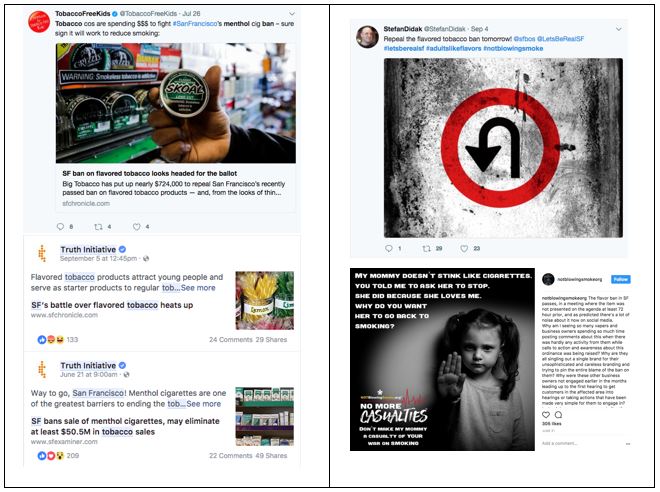
- Expected Outcomes :
The following section elaborates on the impacts of the Flavored Tobacco Sale policy and how San Francisco will implement the policy to mitigate negative impacts.
What are the intended outcomes of the policy?
Prevention of Youth Smoking
By prohibiting the sale and distribution of flavored tobacco products in San Francisco, the policy will most likely lead to fewer youth ever starting to use tobacco products. An evaluation of New York City’s 2010 flavored tobacco product ban (which did not include mentholated cigarettes) found that three years after its implementation, the percent of youth that reported ever using a flavored tobacco product decreased by 20 percent (16). Furthermore, youth surveyed three years after the implementation of the ban in NYC had 28 percent lower odds of ever using any type of tobacco product as compared to youth surveyed before the ban. This study was conducted prior to the emergence of electronic cigarettes and the proliferation of flavored blunts and cigarillos, both of which have strongly contributed to increases in youth smoking rates.1 As such, the Flavored Tobacco Sale policy may result in a greater percent decrease in youth smoking rates than that observed following the New York City ban.Reduced Use of Flavored Tobacco by Communities of Color
While no studies have been done to assess the impact of prohibiting the sale of mentholated cigarettes, it stands to reason that the Flavored Tobacco Sale policy will reduce smoking and tobacco-use rates in communities of color. African Americans, Asian Americans and the LGBTQ community smoke flavored tobacco products at higher levels than the general population; this is particularly true for mentholated tobacco products.17 Eliminating local access to flavored tobacco products will make it less likely for minority youth to start smoking and less convenient for adult smokers to purchase flavored tobacco products. For smokers who use mentholated products, this could have significant health impacts. Documented success rates of quitting are much lower among mentholated-cigarette smokers than traditional smokers, so reducing access to this particular flavor may support current cessation efforts in the community and prevent people of color from becoming addicted to smoking mentholated cigarettes in the future (4).
What should other jurisdictions consider when implementing similar policies?
Assisting Small BusinessesWhile the Flavored Tobacco Sale policy is an important step toward achieving equitable health outcomes, its implementation may reduce revenues for small business owners. Small business owners in San Francisco, particularly the Arab American Grocers’ Association, have been amenable to previous tobacco regulation, such as the Tobacco Retail Density Policy. However, the compounded impacts of successive tobacco regulation over the past few years (e.g., California state-tax increase, retail-density limitations, the regulation of e-cigarettes as tobacco products) have strained their economic stability.
Jurisdictions considering a flavored tobacco sale policy should also consider ways that they could support the economic well-being of their local retailers. Efforts are underway to mitigate the economic losses that small businesses will sustain due to the implementation of this policy. One example is the Healthy Retail SF program, a government initiative that helps small business owners transition their business models from relying on unhealthy products, such as cigarettes, to promoting healthier products, such as fruits and vegetables, whole-grain bread, and low-fat dairy. The program involves tailored support to assist local business owners during the transition, leading to healthier options for consumers and more revenue for business owners. Through this program, small business owners will be supported throughout the implementation of the Flavored Tobacco Sale policy and have the opportunity to become stewards of health in their communities.
Cessation Support
Although the Flavored Tobacco Sale policy is designed to improve public health outcomes for communities of color, eliminating access to flavored tobacco products may impose short-term negative consequences on these same communities. As the inconvenience of maintaining a flavored tobacco use habit increases, current menthol smokers and flavored tobacco product users may choose to quit. Quitting the use of cigarettes or other tobacco products is a physically and psychologically demanding process; appropriate support must be delivered to ease the burden of this transition. San Francisco is increasing resources and its commitment to providing culturally competent cessation resources to support citizens who will be battling nicotine addiction due to the Flavored Tobacco Sale policy. Multiple community-based organizations are committed to developing public education and community-outreach campaigns to make citizens aware of the new policy and where they can find resources to quit smoking.
- Passage of Proposition E:
The Referendum Initiative and No on E Campaign
Let’s be Real, San Francisco, an organization that is financed by the R.J. Reynolds Tobacco Company, gathered enough signatures to petition the Flavored Tobacco Sale policy. The ballot initiative to veto the Flavored Tobacco Sale policy was named Proposition E and over 12 million dollars was spent by the tobacco industry for their “No on E” campaign. Despite the efforts of the opposition, on June 5, 2018, San Francisco Residents voted to keep the Flavored Tobacco Sale policy (Proposition E) in place (68% – yes vs 32% – no).
Formation of SF Kids vs Big Tobacco
Funding from former New York City Mayor Michael Bloomberg allowed for a coalition of organizations, doctors, and advocates to come together and form SF Kids vs Big Tobacco, the 501(c)(4) that spearheaded the Yes on E campaign in San Francisco. The coalition’s grassroots efforts led to garnishing partnership and support of over 100 health coalitions, health organizations, social service organizations, youth serving organizations, political organizations, community leaders, and elected officials throughout the San Francisco Bay Area. In addition, several organizations provided n-kind support in the form of time and resources to coordinate phone banking, garnishing endorsements, and passing out flyers.
Successful Campaign Strategies
Just as with the original policy campaign, several key strategies were used to raise awareness and educate the public about Proposition E. Maintenance of political support, grassroots organizing, and effective messaging were essential in increasing awareness and support of Proposition E among voters.
Political Support
As previously mentioned, Supervisor Malia Cohen championed the original Flavored Tobacco Sale policy and early support from other Supervisors led to a unanimous vote in support of the policy. Stakeholder interviews revealed that getting endorsements a second time was somewhat challenging. To maintain their support, the co-chair of San Francisco’s Tobacco-Free Coalition organized volunteers and they attended meetings with the Supervisors and over 20 political organizations throughout San Francisco. During these meetings, advocates presented a three-minute pitch advocating for Proposition E. This strategy proved to be successful as every mayoral candidate and all but one Supervisor pledged their support for Proposition E.
Grassroots Organizing
SF Kids vs Big Tobacco took a “boots on the ground” approach during the campaign period with volunteers walking door-to-door and hanging door tags at residences throughout the city. These door tags provided an overview of Proposition E and provided a visual depiction of how flavored tobacco products are marketed directly towards children with flavors and labeling similar to candy and junk foods that are often popular among youth. Another grassroots tactic that the coalition utilized was phone banking in which volunteers called residents and encouraged them to vote yes on Proposition E.
Effective Messaging
The key messaging strategy used by the Proposition E proponents was that flavored tobacco products target children. Stakeholders revealed that during the mobilization campaign residents were shocked when they learned that there are over 15,000 flavored tobacco products on the market. At every setting, whether it was a press conference, door-to-door mobilization, phone banking, meetings with local leaders and organizations or interview with a local radio station, advocates reiterated that candy-flavored tobacco targets children and provided local statistics regarding tobacco usage in SF adolescents to support their message.
- Conclusion:
The Tobacco-Free Coalition contributed to the unanimous adoption of the Flavored Tobacco Sale policy by collaborating with a key policy champion on the Board of Supervisors, empowering youth and other stakeholders to engage decisions makers early in the policy process, and using consistent messages to elevate the needs of impact communities. The combination of these factors led to a swift policy-adoption process that was difficult for opponents to mobilize against. Later, the Yes on E campaign utilized similar strategies and grassroots mobilization to gather enough support to successfully uphold the policy during the June 2018 elections. Future policy campaigns to pass flavored tobacco regulation should be prepared to respond to arguments that attack the policy’s economic impact on small businesses and arguments highlighting the use of flavored tobacco as a harm-reduction tool. The San Francisco Flavored Tobacco Sale policy protects the health of those most targeted by the tobacco industry, resulting in the reduction of related health disparities.
No More Flavors: A Case Study Addressing Flavored Tobacco in San Francisco
Bright Research Group
"At the time of its passage, San Francisco’s Flavored Tobacco Sale policy was the most comprehensive flavored tobacco regulation of any municipality in the United States. A key prerequisite for the success of this policy campaign was a dedicated network of community organizations that had trusting relationships with local policymakers."
